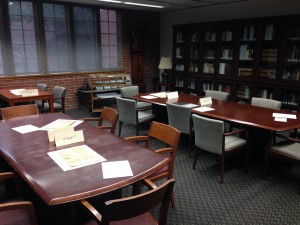 And how better to celebrate than by giving you some behind-the-scenes tours?
And how better to celebrate than by giving you some behind-the-scenes tours?
Let’s say there’s a class coming in tomorrow. The lesson plan was drawn up, the material was chosen, and the students were already notified that they’re going to paying us a visit. What do we do from here? The first order of business is always pulling that material and getting it ready to be set up into groups.
Depending on the subject, our material can either come from the archives or special collections (or both). Special collections is always a bit easier to find for me, since most of our collections are books with call numbers, but the archives is a bit more complicated. Everything comes out of its own collections, whether that’s the President’s Papers, the Photo Collections, the Office of the Dean, the Trail, Ephemera, Alumni Archives, Department Records, the Board of Trustees Minutes… there’s a lot of information stuffed into a single room up here.
For example, we do a session for STS 202 (Science, Technology, and Society II: Since 1800) that discusses women in science at the university. This session is entirely based on archival material. Among the material we use for this class, there’s a “letter to Dr. Vinnie Pease, 1938.” This isn’t enough information to find the letter, and though we do have a searchable database, it’s not quite like Primo.
So in this case, we have a list of documents and each has a note on where it can be found. The letter to Dr. Vinnie Pease can be found in the Alumni Association collection, Box 1, Folder 15, and there’s an extra note saying that it’s the last document in that folder. Once we’ve found the document, we put a marker in that specific folder, exactly where the document was, and label it with an identifier so that when we have to put the letter back, it’s really easy to find its place again. Wash, rinse, repeat for anything else that’s a letter.
Things that aren’t necessarily single documents but instead are bound volumes are pulled in their entirety. Bound volumes of the Trail usually span an entire academic year, so they’ll get a bookmark for the appropriate edition. Tamanawas (the yearbook) and bulletins are pulled, but they don’t get bookmarks. Students usually have a good idea of what to look for in these.
After everything has been collected and divided into their respective groups (we typically have anywhere from three to six groups), the next day we’ll set them all out on the tables, arrange them in an aesthetically pleasing manner, set out handouts if needed, and wait for the class to arrive! If your class has ever been to the archives, you’ll know what to expect from there.
N.B.: These pictures aren’t of our new space, as we haven’t taken any pictures of class set up in our new space, and our storage room is still a bit cluttered.
The Archives & Special Collections is open on Tuesdays, Wednesdays, and Thursdays from 12:00-3:00 p.m. or by appointment.
By: Morgan Ford
